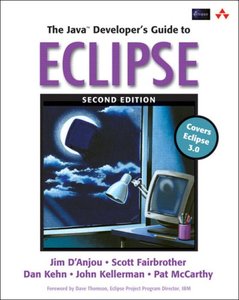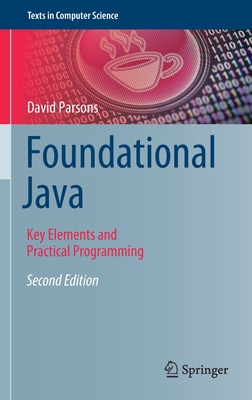買這商品的人也買了...
-
 C Pocket Reference (Paperback)
C Pocket Reference (Paperback)$1,120$1,064 -
 Java Swing 進階篇 (Java Swing,2/e)
Java Swing 進階篇 (Java Swing,2/e)$780$616 -
 Core J2EE Patterns: Best Practices and Design Strategies, 2/e (Hardcover)
Core J2EE Patterns: Best Practices and Design Strategies, 2/e (Hardcover)$2,550$2,423 -
 Eclipse 實作手冊─活用 Java 整合開發環境 (Eclipse in Action: A Guide for the Java Developer)
Eclipse 實作手冊─活用 Java 整合開發環境 (Eclipse in Action: A Guide for the Java Developer)$450$351 -
 $1,078Machine Learning (IE-Paperback)
$1,078Machine Learning (IE-Paperback) -
 Eclipse Cookbook
Eclipse Cookbook$1,740$1,653 -
 Official Eclipse 3.0 Faq (Paperback)
Official Eclipse 3.0 Faq (Paperback)$1,700$1,615 -
 $1,162Java Threads, 3/e (Paperback)
$1,162Java Threads, 3/e (Paperback) -
 Foundations of JSP Design Patterns
Foundations of JSP Design Patterns$1,580$1,501 -
 SWT/Jface In Action: Gui Design With Eclipse 3.0
SWT/Jface In Action: Gui Design With Eclipse 3.0$1,740$1,653 -
 Java Threads 深度探討 (Java Threads, 3/e)
Java Threads 深度探討 (Java Threads, 3/e)$760$600 -
 Introduction to the Theory of Computation, 2/e (Hardcover)
Introduction to the Theory of Computation, 2/e (Hardcover)$1,120$1,098 -
 深入淺出設計模式 (Head First Design Patterns)
深入淺出設計模式 (Head First Design Patterns)$880$695 -
 深入淺出 Java 程式設計, 2/e (Head First Java, 2/e)
深入淺出 Java 程式設計, 2/e (Head First Java, 2/e)$880$695 -
 Java 5 + Eclipse 視窗應用程式開發─實作進銷系統
Java 5 + Eclipse 視窗應用程式開發─實作進銷系統$560$437 -
 Java/Eclipse 系統整合大作戰
Java/Eclipse 系統整合大作戰$600$540 -
 The Definitive Guide to JasperReports (Paperback)
The Definitive Guide to JasperReports (Paperback)$2,660$2,527 -
 JFC Swing 教學手冊 (The JFC Swing Tutorial: A Guide to Constructing GUIs, 2/e)
JFC Swing 教學手冊 (The JFC Swing Tutorial: A Guide to Constructing GUIs, 2/e)$650$514 -
 Java 2 視窗程式設計(適用 JDK 6.0 版), 2/e
Java 2 視窗程式設計(適用 JDK 6.0 版), 2/e$680$537 -
 Eclipse Plug-ins, 3/e (Paperback)
Eclipse Plug-ins, 3/e (Paperback)$2,420$2,299 -
 Silverlight 2.0 精華技術手冊─使用VC#+WPF程式設計(套書)
Silverlight 2.0 精華技術手冊─使用VC#+WPF程式設計(套書)$650$514 -
 $1,540Eclipse Modeling Project: A Domain-Specific Language (DSL) Toolkit (Paperback)
$1,540Eclipse Modeling Project: A Domain-Specific Language (DSL) Toolkit (Paperback) -
 Practical Eclipse Rich Client Platform Projects (Paperback)
Practical Eclipse Rich Client Platform Projects (Paperback)$2,420$2,299 -
 $352Eclipse WTP Web應用開發
$352Eclipse WTP Web應用開發 -
 Eclipse 完全攻略-從基礎 Java 到 PDE 外掛開發
Eclipse 完全攻略-從基礎 Java 到 PDE 外掛開發$600$468
商品描述
Description:
Eclipse is the world's most popular IDE for Java development. And although there are plenty of large tomes that cover all the nooks and crannies of Eclipse, what you really need is a quick, handy guide to the features that are used over and over again in Java programming. You need answers to basic questions such as: Where was that menu? What does that command do again? And how can I set my classpath on a per-project basis?
This practical pocket guide gets you up to speed quickly with Eclipse. It covers basic concepts, including Views and editors, as well as features that are not commonly understood, such as Perspectives and Launch Configurations. You'll learn how to write and debug your Java code--and how to integrate that code with tools such as Ant and JUnit. You'll also get a toolbox full of tips and tricks to handle common--and sometimes unexpected--tasks that you'll run across in your Java development cycle.
Additionally, the Eclipse IDE Pocket Guide has a thorough appendix detailing all of Eclipse's important views, menus, and commands.
The Eclipse IDE Pocket Guide is just the resource you need for using Eclipse, whether it's on a daily, weekly, or monthly basis. Put it in your back pocket, or just throw it in your backpack. With this guide in hand, you're ready to tackle the Eclipse programming environment.
Table of Contents:
Part I
Introduction
What Is Eclipse?
Conventions Used in This Book
System Requirements
Downloading Eclipse
Installing Eclipse
3, 2, 1, Launch!
Specify a Workspace
Exploring Eclipse
Getting Upgrades
Moving On
Part II
Workbench 101
Views
Editors
Menus
Toolbars and Coolbars
Perspectives
Rearranging Views and Editors
Maximizing and Minimizing
Part III
Java Done Quick
Creating a Project
Creating a Package
Creating a Class
Entering Code
Running the Program
Part IV
Debugging
Running the Debugger
Setting Breakpoints
Single Stepping
Looking at Variables
Changing Code on the Fly
Part V
Unit Testing with JUnit
A Simple Factorial Demo
Creating Test Cases
Running Tests
Test First
Part VI
Tips and Tricks
Code Assist
Templates
Automatic Typing
Refactoring
Hover Help
Hyperlinks
Quick Fixes
Searching
Scrapbook Pages
Java Build Path
Launch Configurations
Part VII
Views
Breakpoints View
Console View
Debug View
Declaration View
Display View
Error Log View
Expressions View
Hierarchy View
Javadoc View
JUnit View
Navigator View
Outline View
Package Explorer View
Problems View
Search View
Tasks View
Variables View
Part VIII
Short Takes
CVS
Ant
Web Tools Platform
Testing and Performance
Visual Editor
C/C++ Development
AspectJ
Plug-in Development
Rich Client Platform
Standard Widget Toolkit
Part IX
Help and Community
Online Help
Getting Help
Help Topics
Eclipse Web Site
Community Web Sites
Reporting Bugs
New Account
Searching
Adding an Entry
Newsgroups
Mailing Lists
Conclusion
Appendix
Commands 83
Index 113




























